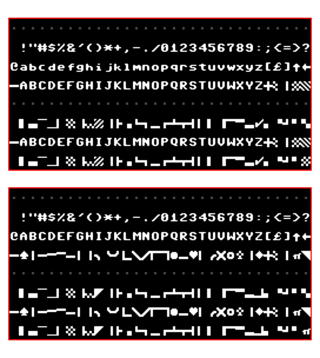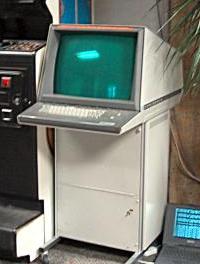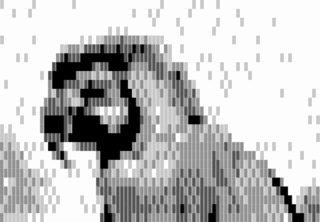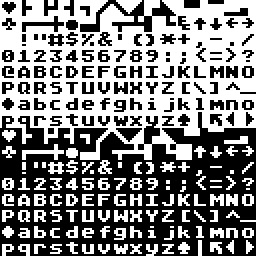
ASCII, an acronym for American Standard Code for Information Interchange, is a character encoding standard for electronic communication. ASCII codes represent text in computers, telecommunications equipment, and other devices. Because of technical limitations of computer systems at the time it was invented, ASCII has just 128 code points, of which only 95 are printable characters, which severely limited its scope. Modern computer systems have evolved to use Unicode, which has millions of code points, but the first 128 of these are the same as the ASCII set.

ASCII art is a graphic design technique that uses computers for presentation and consists of pictures pieced together from the 95 printable characters defined by the ASCII Standard from 1963 and ASCII compliant character sets with proprietary extended characters. The term is also loosely used to refer to text-based visual art in general. ASCII art can be created with any text editor, and is often used with free-form languages. Most examples of ASCII art require a fixed-width font such as Courier for presentation.
In computing and telecommunication, a control character or non-printing character (NPC) is a code point in a character set that does not represent a written character or symbol. They are used as in-band signaling to cause effects other than the addition of a symbol to the text. All other characters are mainly graphic characters, also known as printing characters, except perhaps for "space" characters. In the ASCII standard there are 33 control characters, such as code 7, BEL, which rings a terminal bell.

In computing, plain text is a loose term for data that represent only characters of readable material but not its graphical representation nor other objects. It may also include a limited number of "whitespace" characters that affect simple arrangement of text, such as spaces, line breaks, or tabulation characters. Plain text is different from formatted text, where style information is included; from structured text, where structural parts of the document such as paragraphs, sections, and the like are identified; and from binary files in which some portions must be interpreted as binary objects.
In computer science, an escape sequence is a combination of characters that has a meaning other than the literal characters contained therein; it is marked by one or more preceding characters.

PETSCII, also known as CBM ASCII, is the character set used in Commodore Business Machines' 8-bit home computers.
VISCII is an unofficially-defined modified ASCII character encoding for using the Vietnamese language with computers. It should not be confused with the similarly-named officially registered VSCII encoding. VISCII keeps the 95 printable characters of ASCII unmodified, but it replaces 6 of the 33 control characters with printable characters. It adds 128 precomposed characters. Unicode and the Windows-1258 code page are now used for virtually all Vietnamese computer data, but legacy VSCII and VISCII files may need conversion.

The Tektronix 4010 series was a family of text-and-graphics computer terminals based on storage-tube technology created by Tektronix. Several members of the family were introduced during the 1970s, the best known being the 11-inch 4010 and 19-inch 4014, along with the less popular 25-inch 4016. They were widely used in the computer-aided design market in the 1970s and early 1980s.

The VT50 is a CRT-based computer terminal that was introduced by Digital Equipment Corporation (DEC) in July 1974. It provided a display with 12 rows and 80 columns of upper-case text, and used an expanded set of control characters and forward-only scrolling based on the earlier VT05. DEC documentation of the era refers to the terminals as the DECscope, a name that was otherwise almost never seen.
Several 8-bit character sets (encodings) were designed for binary representation of common Western European languages, which use the Latin alphabet, a few additional letters and ones with precomposed diacritics, some punctuation, and various symbols. These character sets also happen to support many other languages such as Malay, Swahili, and Classical Latin.
A binary-to-text encoding is encoding of data in plain text. More precisely, it is an encoding of binary data in a sequence of printable characters. These encodings are necessary for transmission of data when the communication channel does not allow binary data or is not 8-bit clean. PGP documentation uses the term "ASCII armor" for binary-to-text encoding when referring to Base64.

Extended ASCII is a repertoire of character encodings that include the original 96 ASCII character set, plus up to 128 additional characters. There is no formal definition of "extended ASCII", and even use of the term is sometimes criticized, because it can be mistakenly interpreted to mean that the American National Standards Institute (ANSI) had updated its ANSI X3.4-1986 standard to include more characters, or that the term identifies a single unambiguous encoding, neither of which is the case.

The ZX Spectrum character set is the variant of ASCII used in the ZX Spectrum family computers. It is based on ASCII-1967 but the characters ^, ` and DEL are replaced with ↑, £ and ©. It also differs in its use of the C0 control codes other than the common BS and CR, and it makes use of the 128 high-bit characters beyond the ASCII range. The ZX Spectrum's main set of printable characters and system font are also used by the Jupiter Ace computer.

Text-based semigraphics, pseudographics, or character graphics is a primitive method used in early text mode video hardware to emulate raster graphics without having to implement the logic for such a display mode.

The ZX80 character set is the character encoding used by the Sinclair Research ZX80 microcomputer with its original 4K BASIC ROM. The encoding uses one byte per character for 256 code points. It has no relationship with previously established ones like ASCII or EBCDIC, but it is related though not identical to the character set of the successor ZX81.

The ZX81 character set is the character encoding used by the Sinclair Research ZX81 family of microcomputers including the Timex Sinclair 1000 and Timex Sinclair 1500. The encoding uses one byte per character for 256 code points. It has no relationship with previously established ones like ASCII or EBCDIC, but it is related though not identical to the character set of the predecessor ZX80.

The Atari ST character set is the character set of the Atari ST personal computer family including the Atari STE, TT and Falcon. It is based on code page 437, the original character set of the IBM PC.
Apple II text mode uses the 7-bit ASCII (us-ascii) character set. The high-bit is set to display in normal mode on the 40x24 text screen.
The TRS-80 computer manufacturered by Tandy / Radio Shack contains an 8-bit character set. It is partially derived from ASCII, and shares the code points from 32 - 95 on the standard model. Code points 96 - 127 are supported on models that have been fitted with a lower-case upgrade.
Sharp MZ character sets are character sets made by Sharp Corporation for Sharp MZ computers. The European and Japanese versions of the software use different character sets.













